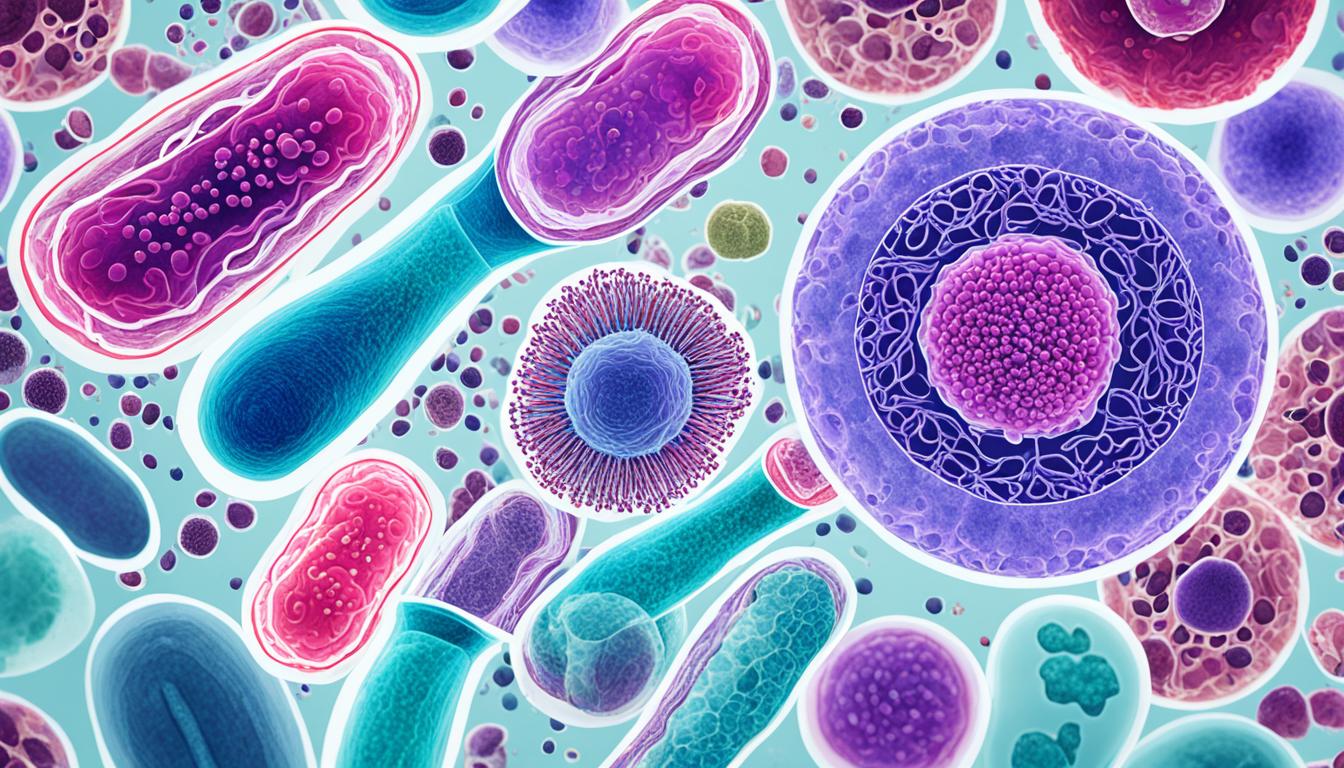Bacterial vaginosis (BV) is a vaginal infection from too much of certain bacteria. This imbalance can cause vaginal odor and unusual discharge. Knowing about BV’s symptoms, causes, and treatments helps in managing it.
Key Takeaways:
- Bacterial vaginosis is an inflammation of the vagina caused by an imbalance in the vaginal flora.
- Symptoms of BV include vaginal odor and abnormal discharge.
- Common causes of BV include bacterial or fungal infections, sexual activity, and poor hygiene.
- Diagnosis involves a physical examination and laboratory tests.
- Treatment options include antibiotics, antifungal medications, and stem cell therapy.
Symptoms of Bacterial Vaginosis
Bacterial vaginosis (BV) comes with symptoms that can be uncomfortable. They show there’s an imbalance in the vaginal flora. It’s key to know these symptoms to seek help quickly.
Common Symptoms
- Vaginal Odor: A distinct, fishy odor is a common symptom of BV. This odor is often more noticeable after sexual intercourse or during menstruation.
- Vaginal Discharge: BV can cause an abnormal vaginal discharge that is typically gray or white in color. The discharge can be thin, watery, or foamy.
- Genital Irritation: Irritation and redness in the genital area, including the labia majora, labia minora, and perineal area, may occur with BV.
- Dysuria: BV can cause pain or discomfort during urination, known as dysuria.
- Dyspareunia: Painful sexual intercourse, or dyspareunia, is another possible symptom of BV.
These symptoms mean there’s an imbalance, with less good bacteria and more bad ones like Gardnerella vaginalis. If you have these symptoms, see a healthcare provider for diagnosis and treatment.
Causes of Bacterial Vaginosis
Bacterial vaginosis happens when too much of a normal bacteria, Gardnerella vaginalis, grows in the vagina. It’s not exactly clear why this overgrowth happens. However, it may be due to changes in the vaginal flora. Sexual activity, having multiple partners, and having a female partner can increase the risk.
Also, poor hygiene and using certain products can cause it. This includes things like spermicides or douches. Allergic reactions might also play a role in triggering bacterial vaginosis.
To recap, the key causes of bacterial vaginosis are:
- Overgrowth of normal bacteria, especially Gardnerella vaginalis
- An imbalance in the vaginal flora
- Sexual activity and many sexual partners
- Poor hygiene
- The use of some products (spermicides or douches)
- Allergic reactions
Knowing why bacterial vaginosis happens is crucial for prevention and treatment. If we understand and address these causes, we can lower the chances of getting it.
Diagnosis of Bacterial Vaginosis
To diagnose bacterial vaginosis, doctors combine a physical check with lab tests. They look inside the vagina for signs like redness or too much discharge. Then, they might take a sample of this discharge. They want to find out what’s causing the problem.
Lab tests are key to confirm if you have bacterial vaginosis. These tests include different checks. They look at how your vaginal fluid looks and measure its pH. They check for a bad odor and look at cells under a microscope for anything unusual.
With these test results, doctors can be sure if someone has bacterial vaginosis. Then, they can figure out the best way to treat it.
Diagnostic Tests for Bacterial Vaginosis
| Diagnostic Test | Description |
|---|---|
| Visual examination | The healthcare provider visually inspects the vagina for signs of inflammation, such as redness or swelling, and excess discharge. |
| Vaginal pH test | A sample of the vaginal fluid is taken and its pH level is measured. An elevated pH level (>4.5) is suggestive of bacterial vaginosis. |
| Whiff test | A small amount of potassium hydroxide (KOH) is added to the vaginal discharge sample. If the sample emits a strong fishy odor, it indicates bacterial vaginosis. |
| Wet mount test | A sample of vaginal discharge is examined under a microscope to detect the presence of clue cells, which are epithelial cells covered with bacteria. The presence of clue cells is highly indicative of bacterial vaginosis. |

Treatment of Bacterial Vaginosis
Bacterial vaginosis (BV) is a condition many women face. It can cause discomfort and affect life quality. Thankfully, effective treatments are available for managing and resolving BV symptoms.
Antibiotics like metronidazole or clindamycin are the main treatment for BV. They can be taken by mouth or applied directly. These medicines work by getting rid of the excess bacteria causing the problem.
If BV comes with a fungal infection, antifungal meds may be used. Medications such as butoconazole or clotrimazole are common choices. They target the fungi, helping to bring back a healthy vaginal state.
Severe BV cases might need cortisone cream or antihistamines. They reduce inflammation and itchiness. This makes symptoms more manageable.
Menopause can lower estrogen levels, leading to BV. Topical estrogen cream can help. It supplements estrogen levels, improving vaginal health.
Each person’s treatment plan can be different. This depends on their health and specific conditions. Pregnant women must tell their doctors about their pregnancy. Some treatments may not fit during this time.
Preventing Recurrence
After treating BV, it’s vital to prevent it from coming back. Good hygiene practices are key. Using mild soaps and wearing cotton underwear helps keep a healthy vaginal environment. It’s also important to avoid douching and other irritants like scented products.
Using condoms can lower BV risks, especially with multiple partners. Being cautious with antibiotics and keeping estrogen levels steady during menopause are also vital steps. These actions help in avoiding BV in the future.
By taking these preventative steps, women can reduce BV’s chances. This leads to a healthier vaginal balance.
| Treatment Option | Method of Administration | Main Benefits |
|---|---|---|
| Antibiotics | Oral or Topical | Eliminates bacterial overgrowth |
| Antifungals | Topical | Targets fungal infection |
| Cortisone Cream or Antihistamines | Topical | Relieves inflammation and itching |
| Topical Estrogen Cream | Topical | Restores vaginal health in cases of low estrogen levels |
Preventing Bacterial Vaginosis
To lower the risk of getting bacterial vaginosis (BV), it’s important to take certain steps. These actions will help keep your vaginal area healthy. This lessens your chances of catching BV:
- Practice good overall hygiene: Keep your genital area clean with mild, unscented soaps.
- Choose cotton underwear: Wearing cotton helps your skin breathe and keeps it dry. This stops bad bacteria from growing.
- Avoid douching and irritating agents: Don’t use vaginal sprays or scented products. They can mess up your vagina’s natural balance and up your BV risk.
- Wipe from front to back: This move stops bacteria from your anal area from reaching your vagina.
- Wear loose-fitting clothing: Loose clothes allow air to flow and keep moisture away. This makes it tough for bacteria to survive.
- Use condoms during sexual intercourse: Condoms can block sexually transmitted infections (STIs) that might lead to BV.
- Use antibiotics only when necessary: Taking antibiotics without needing them can harm your vaginal flora. This could lead to BV. Only take them as your healthcare provider instructs.
- Maintain healthy estrogen levels during menopause: Falling estrogen levels can make you more likely to get BV. Talk to your doctor about keeping your estrogen levels up.
Following these steps greatly reduces your chance of getting BV. Proactive care for your vaginal health boosts your overall wellness. It also lowers your risk of discomfort and other issues BV can cause.
Conclusion
Bacterial vaginosis is a common issue that causes discomfort. Symptoms include vaginal discharge and a bad odor. It happens when there’s too much of certain bacteria in the vagina.
Getting diagnosed and treated for bacterial vaginosis is key. It helps relieve symptoms and stops further problems.
Stem cell therapy might be a new way to treat it for some people. Keeping clean and taking steps to avoid it can lower your chances of getting bacterial vaginosis. Always talk to a healthcare provider if you think you have it. They can confirm it and suggest the best treatment.

